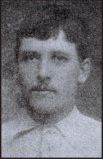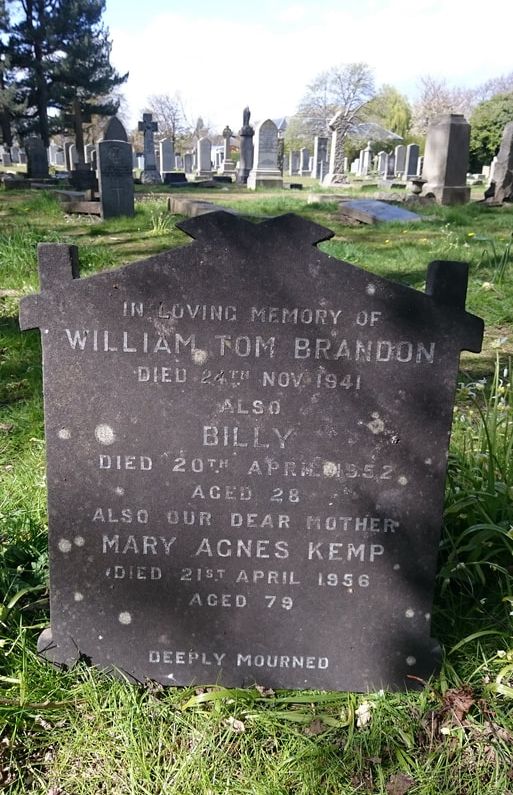William Thomas "Tom" Brandon
(and James, Bob and Harry Brandon)

Tom Brandon, actually christened William, and brothers, James and Robert (Bob), plus cousin Harry were all part of an extended, second-generation, Irish family that first settled and then spread out from Ayrshire. Their fathers had found work as miners, shale and coal, but the sons' future was professional football, Tom, after himself shale-mining, as a full-back, Bob a centre-forward, James an inside-forward and Harry a wing-half. Throw in other brothers and cousins are they might had a full, outfield team. But only one, William Thomas, known as Tom, whose son by the same name would also go on to play professionally, would gain international honours.
All four boys were born in Glengarnock by Kilbirnie. Both families moved to Kilbarchan and it was there the brothers at least learned their football, locally at Clippens or Klippens by Linwood and then with junior clubs, Tom at Johnstone or Renfrew, Harry at Haywood Wanderers, probably the team from the now disappeared shale-mining village in Lanarkshire of the same name, James at Port Glasgow. But they would all gravitate to St. Mirren, Tom in February 1887, James from June, Bob from August, and Harry from 1889. In fact in 1889, after from 1887-89 all three of the brothers being in the team, for a month all four footballing paths run in parallel. Only in May 1889 did they begin to take their differing paths, Bob after fifty-one appearances at twenty-eight to Clyde, Tom with seventy-three at twenty-two to Blackburn and most-used James with eighty at twenty-three back to Port Glasgow. Perhaps encouraged Harry would himself move on only a year later also at the age of twenty-three and again South, to Sheffield, The Wednesday and over one hundred and fifty appearances over eight seasons and an FA Cup win.
Specifically Tom's talent had been recognised early locally. He represented Renfrewshire from twenty, winning its its Cup in 1888, that is before Rovers came in. And for them he might even have gone considerably better in winning the FA Cup that very next season, except he was ruled ineligible before the semi-final and thus for the final. However, it was a hands-on-a-the-prize delayed. The paperwork was sorted and the next season he was there to the end as the trophy was retained.
However, despite victory Tom had other plans. He had already signed for Sheffield Wednesday, there to be captain, but he did rapidly return to Blackburn, recorded as a joiner, to marry publican's daughter, eighteen year-old Elizabeth Duckworth. They were in 1893 to have just the one son, the future footballer, as Tom that same year tried to return to her hometown and its club, but was initially blocked. So instead he walked away, dropped out of the Football- into the Lancashire-League with neighbouring Nelson for three months until matters were resolved.
However, now back at Blackburn on the field off the field the marriage floundered. In 1895 he he was convicted of cruelty, a separation was granted as was maintenance. Yet, winning a first and only cap in 1896, he played on in the town until 1900, before at the age of thirty-two he returned to St. Mirren and Paisley until the end of the 1900-01 season. There he was soon back in court for non-payment of maintenance, which may have been a reason for what is said to have been his next move at the age of thirty-three, emigration. He is supposed to have gone to the USA, specifically to Rhode Island, where there had been a strong, now reviving, semi-professional footballing culture, to which several ex-Scottish pros had gone with some success.
But no record has been found so far of him footballing or otherwise either in the USA or in Scotland during the two decades until 1921, when he is back living in central Edinburgh. There he is recorded as coal-miner, with six children, all born after 1902, all in the Central Fife coalfields, and a new "wife", Mary. But there are three problems. The first is that he had not married Mary and never would, although they were to live together for at least twenty, perhaps thirty years. The second is that the children are not all recorded as his. For the three eldest the father is given as a William Morrison, who Mary seems to have wed in 1895. Only the youngest three are said to be Brandons, the eldest born in 1908, and even then their birth-certificates, signed off by their father, actually show them also as Morrisons. The third is that "William Morrison" just seems to disappear but there is no register of death, all of which provides a reason for Brandon/Kemp non-marriage - the potential for bigamy, perhaps doubly-so - and two possible alternative scenarios for Tom's life after football.

The first is that Tom Brandon, after having been taken to court by his wife for money in 1901, did go abroad and then returned to hook up with Mary. The second is he simply let it been known he had gone abroad but chose instead to merge into the mining communities of Fife and/or East Lothian. And there he had met Mary, finally settling with her back in the city, where she had been born, brought up and, indeed, married.
Bob Brandon would die in Dumbarton in 1950. Harry had died in Rotherham in 1935, James in Dunfermline in 1942. Tom would pass away still in Edinburgh in 1941 at the age of seventy four, Mary outliving him by fifteen years. And they are buried together with one of "their" children in the city's Warriston Cemetery.
Birth Locator:
1867 - Glengarnock, Kilbirnie, Ayrshire
Residence Locations:
1871 - 17, Klippens Sq., Kilbarchan, Renfrewshire
1881 - 47, Klippens Row, Kilbarchan, Renfrewshire
1891 - 8, Bicknell St., Blackburn, Lancashire
1901 - (31, Maxwellston, Paisley)
To USA?
1911 - N/A
1921 - Calton, Edinburgh
1941 - 18, Keir St., Edinburgh
Death Locator:
1941 - 18, Keir St., Edinburgh
Grave Locator:
Back to Johnstone & Paisley,
the Cart Trails
or the SFHG Home page